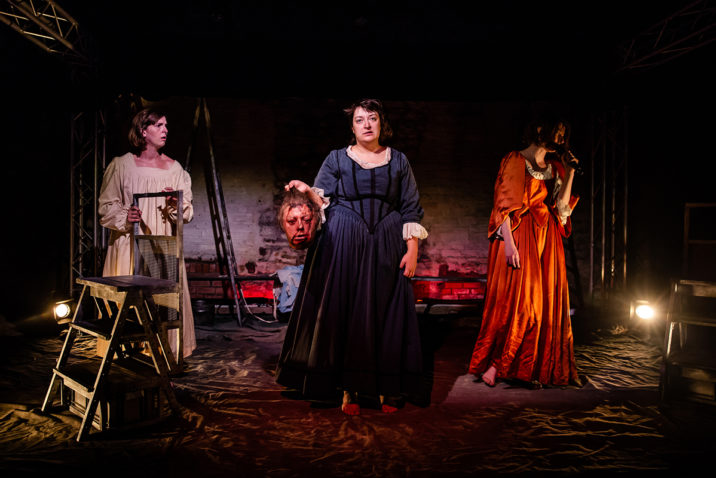‘It’s True, It’s True, It’s True’ is a remarkable portrayal of Artemisia Gentileschi’s experiences during a trail in 17th century Italy. Born in Rome to Orazio Gentileschi and Prudentia Montone, Artemisia was a prodigious painter who, as it now transpires, rivalled many of her peers, including Caravaggio.
The play opens in a courtroom where an all-female cast – Ellis Stevens,
Sophie Steer and Kathryn Bond – skilfully play multiple parts (judge, lawyer, accused, accuser and witnesses). This switching of roles takes getting used to but the actor’s individual interpretation of each of their characters is so deft that we’re quickly immersed in the renaissance period. Ellis Stevens’ forceful yet reserved portrayal of the young Artemisia is riveting and acts as a counter-weight to Sophie Steer’s acerbic portrayal of Agostino Tassi, the accused rapist.

To briefly summarise: it’s 1612 and Artemisia accuses Agostino of rape. In essence, this is a courtroom drama in which two stories are being told; the first, that of Agostino Tassi whose brazen and dismissive sense of entitlement and privilege is breath-taking – all the more so as he’s played by a female. Sophie Steer’s delivery holds a mirror to our contemporary society and men’s behaviour in it. The post-show discussion confirmed that when reviewing the original (translated) court transcripts which informed the writing, the team were influenced by the #metoo and #timesup movements which were started as a way to stand up to sexual assault.

The second story is about a female with a precocious talent for painting, a skill achieved during a period when the art form was dominated by men. While her works were commissioned by royalty, nobility and the clergy and hang in prestigious galleries, most people had never heard of her as an artist. The play takes great leaps to address this balance by interjecting within its timeline an opportunity to depart from the court room and physically reinterpret two of Artemisia’s key works: ‘Susanna and the Elders’, and ‘Judith Slaying Holofernes’. Both of these acts were executed superbly and helped promote Artemisia’s artistic motivation – as they were created shortly after (and possibly in response to) her being raped.
The pre-baroque stage design and music that underpin the play are unsung heroes of this production. They skilfully manage to capture the essence of the century and age; yet, through wisely curated signature music choices, the piece feels contemporary; an example here would be Marvin Gaye’s ‘I Heard It through the Grapevine’ sung with a female lead. Everything simply worked.

The Courtroom scenes have our protagonists dressed in Tarantinoesque black suits and white shirts. This sets the initial tone for the piece. The second act sees the actors dressed in more traditional renaissance attire as they act out rather than narrate proceedings. This provides a degree of realism, giving us an insider’s guide to events as they happen.
As for Agostino Tassi, the message appears to be that characters like him have always existed and do so today. This retelling of Artemisia’s story acts as love letter to all those who think they may be alone in their struggle.
★ ★ ★ ★Breach Theatre presents It’s True, It’s True, It’s True at Home, Manchester from 8-12 October 2019. See website for more dates.









